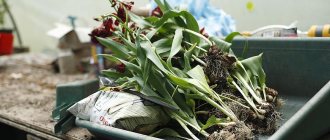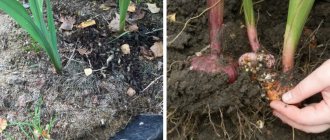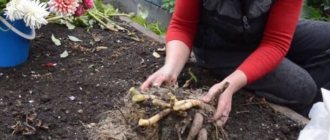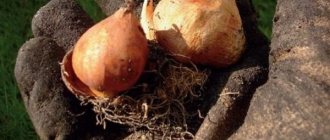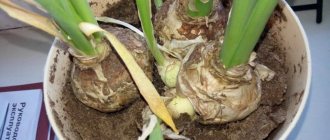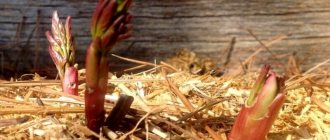If you don't want your tulips to become shriveled and degenerate over time, you need to know when to dig up your tulips and store them.
Unfortunately, many gardeners neglect this agricultural technique. Dear readers!
For you, we have created communities on social networks in which useful articles and interesting ideas are published several times a day! Subscribe and receive useful content in a convenient format! But digging up tulips is very important if you want to preserve the varietal characteristics of specific plants, as well as propagate flowers to form a beautiful flower bed.
In this article we will talk about the timing of digging tulips in different regions and preparing the bulbs for storage. You will also learn about the features of storing planting material until the new summer season.
When to dig up tulips after flowering and how to choose the time?
When determining the time when to dig up tulips, first of all, pay attention to the condition of the leaves of the plant. It is considered optimal to dig up the rhizomes when the above-ground part begins to turn yellow, but has not yet completely dried out. This means that the plant has completed the cycle and is going into a dormant period.
It makes no sense to dig up earlier, since the plant has not yet finished its growing season and has not been saturated with the nutrients it needs. There is also no need to wait for the foliage to completely dry out, because then you simply won’t be able to find all the bulbs.
Having received planting material in June-July, you will, firstly, be sure that you have dug up all the tulips. Secondly, you can separate fused nests and get new planting material. Thirdly, in the time before planting, the bulbs will rest and gain strength for flowering in the new season.
INTERESTING! In Central Russia there is such a sign. As soon as the day begins to decrease, you need to dig up the tulip bulbs. That is, after June 22.
Time selection depending on region
Russia is a large country, and in different regions, depending on climatic conditions, tulips are dug up at their own time. Let's consider when it is necessary to carry out the procedure in different areas of our vast Motherland.
Southern regions
In the south of the country, you can start harvesting tulips at the beginning of summer. At this time, the plants will have finished flowering and will be ready for the dormant period.
Middle lane
In the regions of the Middle Zone, tulip bulbs are traditionally dug up from the 20th of June until the second ten days of July. A specific day is chosen depending on the weather and the condition of the plants themselves.
Moscow and Moscow region
In the capital region, bulbs are dug up in the last days of June and the first days of July.
Leningrad region
In St. Petersburg and its environs, bulb harvesting can be done starting in the second ten days of July.
Volga region
In the Volga region, tulips can be dug starting from the last days of June.
Ural, Siberia, Far East
In the eastern regions of the country, the time for harvesting bulbs occurs in the last days of July - the first days of August.
Digging time
Tulip bud finishing flowering
When industrially growing flowers, for example for sale, the bulbs are dug up immediately after flowering. This occurs for expedient reasons: the land is required for other crops. When breeding on your own site, there is no need for such a rush. But you shouldn’t wait until the above-ground green part of the flower is completely dry.
The timing of excavation varies slightly for different regions. So, in the northern regions, bulbs are selected from mid-July to early August. In the southern zone with a warm climate, this period occurs at the end of June - beginning of July. The same time is also suitable for mid-latitudes.
But many gardeners usually adhere to the following rules: you need to dig up tulips after one third of the leaf has yellowed. Then the nests of bulbs are kept intact and do not fall apart.
There is another way to determine the desired period: the end of the stem becomes elastic and can be easily twisted around your finger. The period for removing the bulbs for storage also depends on the time of flowering of the tulips. The sooner the plants fade, the earlier the digging period begins.
If spring and early summer turned out to be inclement, then you should not adhere to generally accepted deadlines. You can dig up the bulbs without waiting for the leaves to turn yellow. They can be kept in containers or boxes with soil for general ripening. Plants can be removed with leaves and peduncles, then sprinkled with soil and placed in a warm, dry place for two weeks.
How to properly dig up tulip bulbs?
It is better to choose a dry, sunny day to “harvest” tulips. It is better to dig with a pitchfork, trying not to touch the rhizomes. With experience, you will be able to use a shovel, but it is better to start with a pitchfork.
In any case, the shovel or fork should be held vertically, almost perpendicular to the ground. This is done so as not to damage the rhizome when the bulb is deep.
However, do not dig to the very root of the tulip. Step back a few centimeters so as not to leave children in the ground.
After digging up the bulbs, carefully shake off the soil and place them in a basket or box. You will prepare them for storage a little later.
Don’t forget that you must remove the “babies” from the soil along with the main bulbs. These shoots can be used to propagate and plant tulips in other areas of your garden.
IMPORTANT! Do not tear the stem and leaves from the bulb. They will then fall off on their own during drying.
Preparing for digging
Cutting tulips
Experienced gardeners advise cutting off the flowers of tulips 3-4 days after they open. Or remove the seed capsule after flowering. This will help the plants not waste energy setting seeds and will cause an influx of nutrients from the above-ground parts to the bulbs. This way they will gain strength for subsequent storage and flowering.
After flowering, it is advisable to feed the tulips; this will help the plant develop immunity to various diseases. The choice of fertilizers today is large, for example, you can use one of the complex fertilizers: Azofoska, Kemiru, Universal-2. All the substances necessary for plants are correctly distributed in them.
Advice! When cutting tulips for a bouquet, you do not need to completely remove the entire green part. It is better to leave the plant with 3-4 leaves. This will promote the formation of large, healthy bulbs suitable for planting next season.
The preliminary preparation of tulips includes trimming the stem. Such actions will help the bulbs ripen faster. After pruning, the flowers are watered with settled water. Although tulips love water treatments, you should not overwater them, turning the planting site into a swampy area. Watering stops a week before the appointed day.
When to plant tulip bulbs after digging
The good thing about tulips is that their bulbs will be ready for planting in just a few months. For example, children can be seated in the second half of August and the first ten days of September. Adult bulbs are planted a little later, from September to November.
The main condition in this case is that the earth must have time to cool down to AT LEAST 10 degrees.
Why is it important? The fact is that tulips are considered one of the primroses, which means they begin to germinate in relatively cold soil.
It is also possible to plant plants in the spring, but in this case they will bloom much later.
The most experienced flower growers plant tulips literally 1.5-2 weeks before frost. But in this case, they carefully mulch the plantings and additionally cover everything with branches, leaves and even agrofibre.
Bulb sorting
Cooked tubers need to be sorted. They need to be carefully examined and specimens of irregular shape and with the slightest signs of mold damage that were not noticed before should be rejected.
Did you know? In the first half of the 17th century. tulips were very highly valued in Europe. A bouquet of these spring flowers cost more than building a new house.
The remaining beautiful bulbs of the correct shape are sorted by size:
- small - 1.5 cm in diameter;
- medium - 3 cm;
- large - 4 cm or more.
This sorting of seeds by size is important for proper planting. Small and medium-sized tubers will not produce flowers in the first year, so it is best to grow them not in a flower bed, but somewhere in a secluded but sunny place.
We recommend reading how to grow tulips in a greenhouse by March 8th.
How to prepare bulbs for storage step by step
Now let's look at the algorithm for preparing tulip bulbs for storage.
Step 1. You have removed all the bulbs from the soil. Inspect them and set aside any that are rotten, diseased or damaged.
Step 2 : Calibrate. By sorting the bulbs by size, in the future you will be able to organize a flower bed and plant them beautifully.
Step 3 : Clean. It is necessary to remove adhering soil, roots, peeling husks, etc.
You may also need to cut off any rotten areas on the bulb. Please note that if there is little rot, then it is easier to remove it, but if there is a lot, then the onion will have to be thrown away.
And don’t forget to treat the cut area with potassium permanganate and crushed activated carbon.
An important point about the husk. There is no need to specially “undress” the bulbs. Clean off only those scales that easily come off on their own. Otherwise, you may damage the rhizome.
Step 4. Drying the planting material. The bulbs must be dried before storing.
This can be done by placing the rhizomes in mesh boxes in 1 - 2 layers. There is no need to apply more, as then the process of rotting may begin.
Drying time can vary from several days to 2 weeks. Everything, as you understand, depends on the weather.
Step 5. Disinfection. The simplest way to disinfect planting material is to soak it for several hours in a pale solution of potassium permanganate. Don’t forget that you need to dry the bulbs again later.
Step 6. Bookmark for storage. Choose the method that suits you to store planting material and do not forget to provide the necessary storage conditions.
ON A NOTE. If the bulbs have grown together into nests, then they need to be carefully separated, peeled, cut off the roots and soaked for 30 minutes in a weak solution of potassium permanganate. Then they are dried again and sent for storage.
How spring bulbs grow
All early bulbous flowers listed at the beginning of the text belong to different families:
tulips - lily;
daffodils - amaryllis;
crocuses - iris;
hyacinths - asparagus.
However, in addition to early flowering, they have several common properties.
First, the mother bulb annually forms daughter bulbs, which are “pushed” upward towards the warmth and sun, while at the same time it gradually goes deeper into the ground until it disappears completely. The more complex and beautiful the hybrid, the faster this substitution occurs. In some species varieties, the mother bulb remains viable for only 2 seasons.
Secondly, the formation of large and full-fledged flower buds for the next season, for example, in tulips, occurs at a temperature not lower than +20-22 degrees. In the soil at the depth of the bulb, such temperatures occur only in the geographic regions where botanical species grow, but are unattainable in Russia, with the exception of perhaps the southernmost regions.
Third, the above-ground part of the plant dies off completely when the bulb goes dormant before the next season. Spring bulbs are invisible during this period - they are difficult to dig up for transplanting to a new place, and can be easily damaged when loosening the soil.
In summary, it makes sense to dig up spring bulbous flowers in order to preserve their varietal characteristics, obtain large flowers and simplify the process of planting new flower beds for the next season. An additional argument in favor of digging is the problem of monoculture cultivation: when one type of plant remains in one place for a long time without replanting, it accumulates diseases, attracts traditional pests and depletes the soil, drawing out from it the microelements it needs.
Methods for storing planting material at home
Planting material should be stored in a dark, warm place (about 20 - 23 degrees Celsius) without dampness. The room should be well ventilated. Boxes with holes made or baskets are ideal for containers.
ON A NOTE. It would be ideal to gradually reduce the storage temperature of tulips. Start with 25-27 degrees and end at around 20 degrees. But, unfortunately, not everyone can afford this storage method.
The bulbs are laid out in one layer. They need to be laid out so that they do not come into contact with their neighbors. Tulips folded in boxes can be sprinkled with dry sand or sawdust.
However, there are other ways to preserve planting material.
It is very convenient, for example, to store onions in egg cassettes. Then each bulb will have its own cell. No need to use bulk materials.
A cheap but practical option is to store the bulbs in nylon stockings, string bags and fabric bags.
IMPORTANT! Do not use iron or plastic containers, plastic bags or glass jars as storage containers. If there is no free air circulation, the bulbs will inevitably begin to rot.
Experienced flower growers advise periodically inspecting tulips during storage (once every 2 months is enough) in order to notice putrefactive processes in time and save the bulb.
ON A NOTE. There is a storage method called “wet germination.” Wet sawdust is poured into the container (preferably peat, if you have it). Onions are planted in them and again sprinkled with peat or sawdust. Then the container is removed to the basement and stored until disembarkation.
Do I need to dig up hyacinths?
Hyacinths bloom only when they are minimally buried in the soil and overwinter at temperatures not lower than -15 degrees. In central Russia, these are mutually exclusive conditions, so large-flowered garden hyacinths are dug up annually and the awakened bulbs are replanted in April-May, or used for potting.
The exception is muscari - dwarf or “mouse” hyacinths, which overwinter without problems in the ground in almost any geographical area. Muscari bulbs are dug up every 5-6 years to divide the bush.
Features of storing planting material in winter, and what conditions are needed
Sometimes it happens that it is not possible to plant tulips in the fall. In this case, the bulbs need to be stored for winter.
Preparing planting material for wintering does not differ from the standard procedure. You dry and disinfect the rhizomes.
Larger specimens (from 3 cm) are left for stocking for the winter.
It is very important to prepare your storage properly.
Firstly, it should be dry there, there should be no access to sunlight. A cellar, basement, or attic are quite suitable.
If there are few bulbs, you can put them in the refrigerator. But keep in mind that refrigeration is a last resort. Not all bulbs will survive such low temperatures.
The most important point is the temperature regime. Ideally, the temperature of tulip planting material is gradually reduced from 25 to 15 degrees. The reduction occurs once a month.
Are there varieties that don’t need to be dug up?
Variety Johann Strauss
There are varieties whose bulbs do not require annual removal from the soil. These are mainly varietal variations of tulips from the group of Foster, Kaufman and Greig. These species are botanical and reproduce very slowly.
Pinocchio variety
Here are the most popular of these varieties:
- Johann Strauss;
- Giuseppe Verdi;
- Heart's Delight;
- Ali Baba;
- Princess Charmant;
- Sylvia van Lennep;
- Pinocchio;
- Passionale.
Variety Hearts Delight
But this does not mean that having planted botanical tulips in your garden once, you can forget about them. Bulbs of these species also need to be dug up, they just do this not annually, but once every 4-5 years.
Is it possible to store diseased and thrips-infected bulbs?
There is still controversy regarding the storage of diseased bulbs.
Some gardeners are absolutely sure that infected or rotten planting material should be thrown away so that the infection does not affect other tulips.
This is a common sense approach. After all, it is better to sacrifice a few specimens than to receive completely infected planting material.
Others disagree with them. And here too there is a grain of truth. If you remove the infected areas and treat them with antifungal and insecticidal agents, the bulb will sprout as if it were healthy.
Here you need to decide for yourself. But, if you want to save the maximum number of bulbs, here are some useful tips:
- Sick and infected rhizomes are stored first.
- Be sure to place them separately so as not to infect other bulbs.
- Treat infected planting material. To do this, you need to remove the diseased areas (if there are few of them and they are small), treat them with crushed coal and soak the tulip bulbs in a solution of potassium permanganate or Fundazol.
- During storage, inspect the problematic planting material at least once a month; if rotting processes continue, then destroy the infected bulbs without regret.
Planting process
After completing all the preparations, you can proceed directly to planting the bulbs in an open flowerbed:
- Dig holes or grooves to a depth of 15 cm. Place crushed eggshells in them and sprinkle sand on top.
- Remove the bulbs from the disinfectant solution, roll them in wood ash and sand.
- Place the bulbs in the holes or grooves with their bottoms down at a distance of 20-30 cm from each other.
- Carefully cover the bulbs with soil. Watering should be done after 2 weeks with warm water.
- After another 2 weeks, mulch the beds using sawdust, fallen dry leaves or peat.
- With the onset of spring warmth, the mulch must be removed from the beds so that the seedlings can germinate unhindered.

